Kansas is a beautiful natural state with plenty of landscape and bodies of water. It’s known as the Sunflower State, the Wheat State, and the Jayhawk State for obvious reasons.
Kansas is also home to 479 different species of birds, including the elusive hummingbird.
Some hummingbird species are considered a rare sight in Kansas, but there is always the possibility of seeing them during the migratory season.
If you live in or plan to visit Kansas and you’re a hummingbird enthusiast, then this list is for you! Keep reading to find out which hummingbirds you might be able to see throughout the state.
Hummingbirds You Can Find In Kansas
There are nine different hummingbird species that you can find in Kansas—one of them is a regular to the state, while the other eight species are a rarer sight. So, let’s learn about the hummingbirds you may be able to see in Kansas.
Anna’s Hummingbird
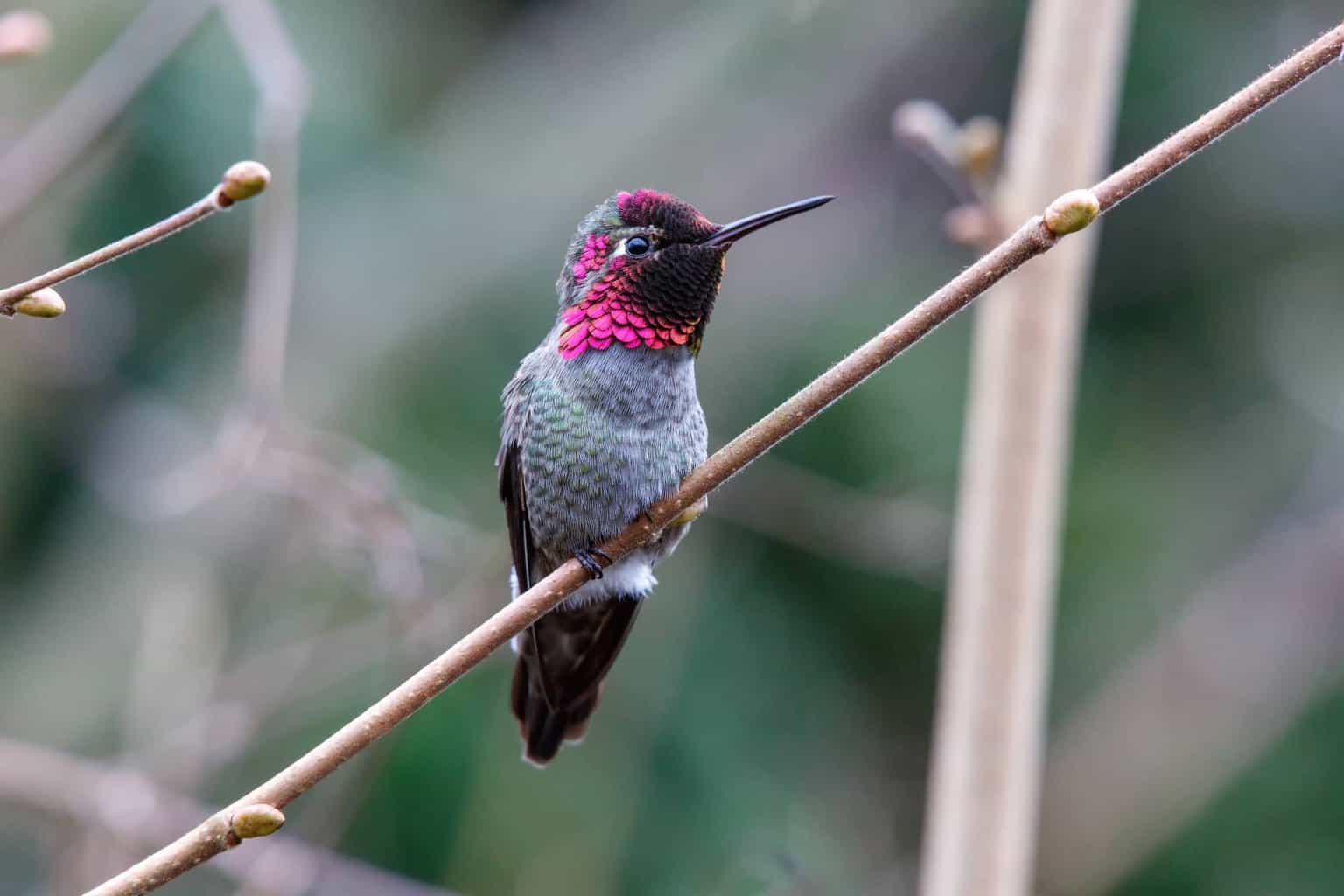
- Scientific Name: Calypte anna
- Length: 9 – 4.3 inches
- Weight: 1 – 0.2 ounces
- Wingspan: 7 inches
- Native To: Western and Coastal Regions Of United States
Description:
Male Anna’s hummingbirds have glossy and dark red crowns and throats, appearing black in low light. The underside of the males is grayish, and their backs are metallic green.
The females of this species have light gray chests with red and white spots on their throats. They also have green backs, and their tails have white tips.
Additional Information:
Anna’s hummingbird is one of the largest and most vocal hummingbirds in the United States, and the male hummingbirds are more vocal than the females.
These hummingbirds are known to be territorial, and they will fight or chase off other hummingbirds from their territory, they will sometimes even attack humans that come too close.
Anna’s hummingbirds are similar to Costa’s Hummingbird, with Costa’s hummingbird only having a larger gorget. These hummingbirds primarily feed on nectar, but they will also eat small spiders and insects.
Allen’s Hummingbird
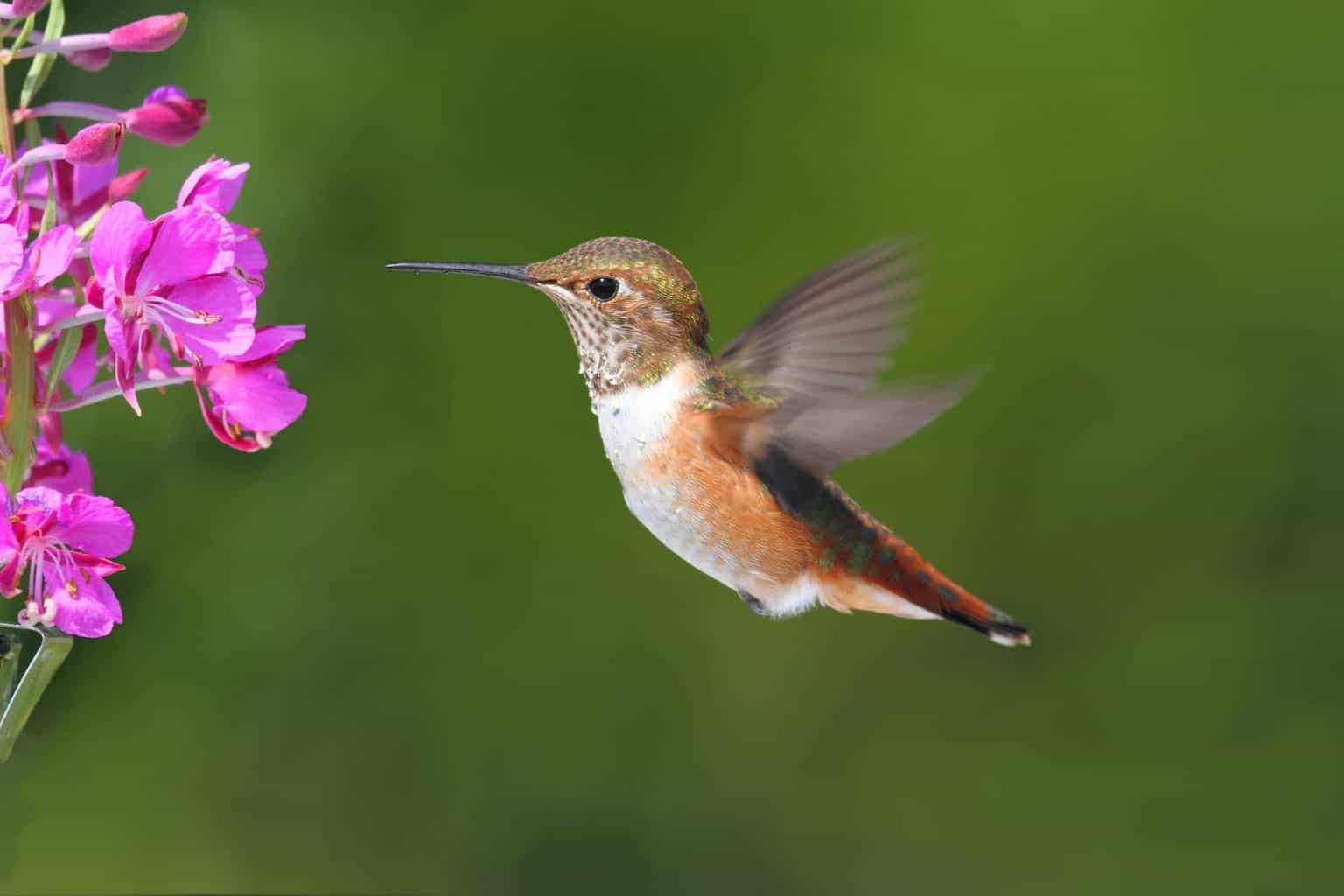
- Scientific Name: Selasphorus sasin
- Length: 3 — 3.5 inches
- Weight: 071 – 0.176 ounces
- Wingspan: 3 inches
- Native To: Western United States
Description:
The males have green feathers on their foreheads and backs, and Rufous hummingbird-colored (rust-colored) rumps, flanks, and tails. The males have a lovely iridescent reddish-orange color on their throats.
The females are very similar in color to the immature Allen’s hummingbirds; however, they lack the iridescent patch on the throat, and instead have a series of green speckles.
The females are primarily a metallic green, and have some features in a Rufous hummingbird color on their tails, with white tips.
Additional Information:
Allen’s hummingbirds spend most of their time in the Western United States, but they do migrate for the winter, so you may have a chance of spotting them in Kansas.
These hummingbirds are very similar in appearance to the Rufous hummingbirds. The only way to tell them apart is that an Allen’s hummingbird will have a notch in the second rectrix.
There is also a hybrid between Allen’s hummingbird and Anna’s hummingbird, known as the Floresi’s hummingbird.
Black-Chinned Hummingbird
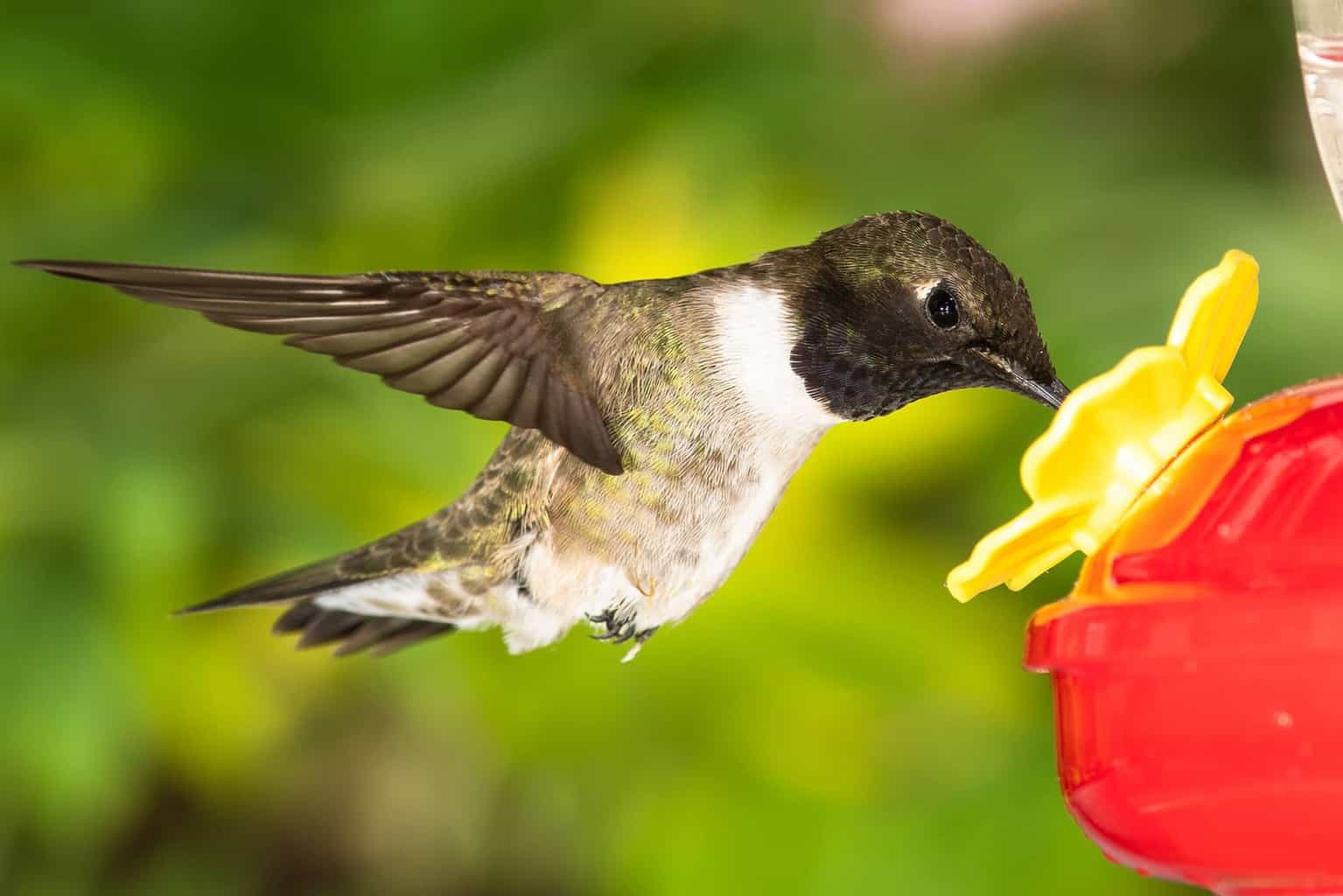
- Scientific Name: Archilochus alexandri
- Length: 25 inches
- Weight: Unknown
- Wingspan: Unknown
- Native To: A large range around the United States
Description:
The Black-chinned hummingbird is not sexually dimorphic, so the adults look pretty similar, with only slight differences in their coloration.
Adult Black-chinned hummingbirds have a metallic green on their backs, with white bellies and green flanks. Their bills are straight, long, and very thin.
The male and female differ in that the male has a black chin and face, with a glossy purple band across its throat and dark, forked tail feathers. The female Black-chinned hummingbird has a dark but rounded tail with white tips and no purple on her throat.
Additional Information:
This small migratory bird has a broad range of habitats, and it can migrate as far south as Mexico for the winter.
The Black-chinned hummingbird will cross-breed with many different hummingbird species. The Black-chinned/Anna’s hummingbird hybrid has its own name: “Trochilus violajugulum.”
The color of juvenile Black-chinned hummingbirds is very similar to the adult female hummingbirds with just slight differences; the juveniles have buff margins on their sides. If the juveniles are males, they will have purple on their throats.
Black-chinned hummingbirds can be found in many habitats, including woodlands, mountains, meadows, orchards, and chaparral habitats.
Broad-Tailed Hummingbird
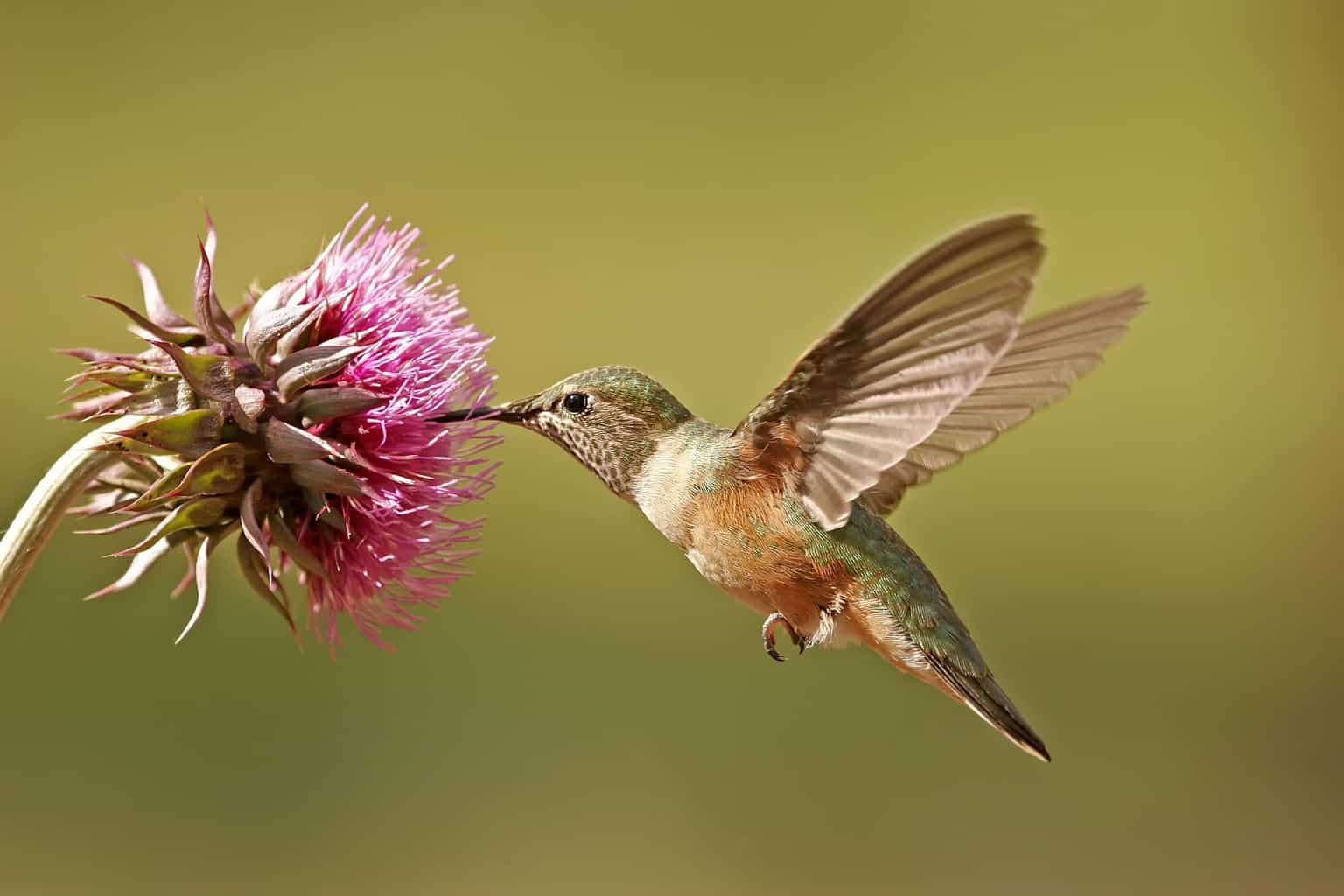
- Scientific Name: Selasphorus platycercus
- Length: 4 inches
- Weight: 13 ounces
- Wingspan: 25 inches
- Native To: Western United States, Western Canada, Mexico, and Guatemala
Description:
This bird has an iridescent green back, with a white eye-ring and a rounded black tail that projects beyond the tips of their wing. There are some differences, the male hummingbird has a bright rose-red gorget, and the female does not.
The female can further be distinguished from the male due to her paler coloration, cinnamon-colored flanks, and spotted checks.
Additional Information:
The Broad-tailed hummingbird is medium-sized and is a migratory bird. This hummingbird shows sexual dimorphism; the males and the females have similar characteristics, but the female is larger than the male.
The Broad-tailed hummingbird prefers a habitat under tree canopies of oak and pine woodlands. This hummingbird will forage for food in open areas among the shrubs, trees, and flowers.
Costa’s Hummingbird
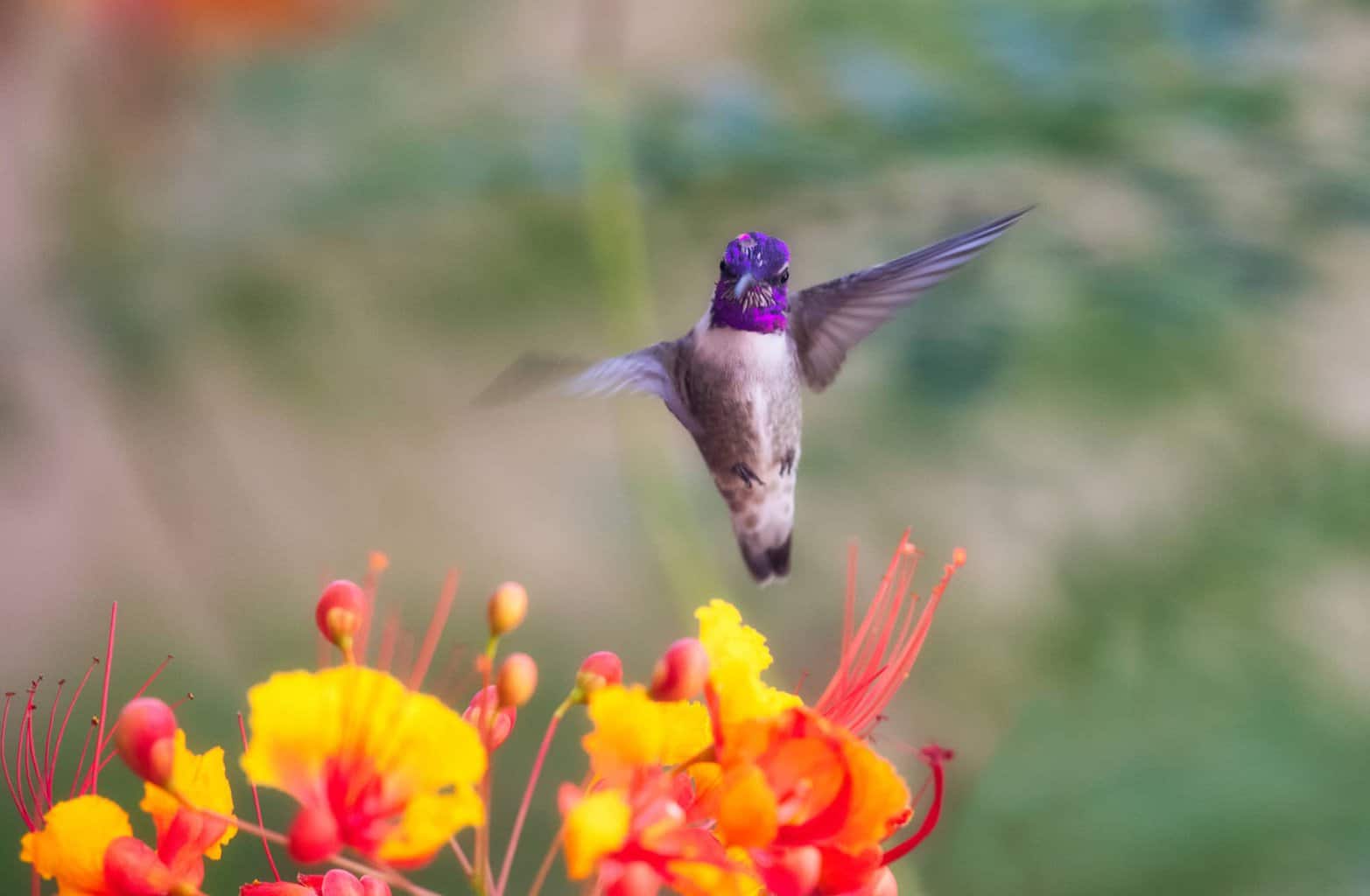
- Scientific Name: Calypte costae
- Length: 3 – 3.5 inches
- Weight: 1 – 0.11 ounces
- Wingspan: 3 inches
- Native To: Northwest Mexico, Central America and Southwest United States
Description:
Costa’s hummingbirds are not sexually dimorphic. The male is identified by a glossy purple crown and long throat feathers that project down the sides of the throat, giving him a “mustache” appearance. Males also have metallic green backs.
Alternatively, the females have crowns that are a garish green, and their backs are this color too. Their chins and the feathers on their bellies are white, with their throats having a few black spots.
The females’ flanks are a buffy color, and they have a dark tail with white tips decorating the outer tail feathers.
Additional Information:
These hummingbirds are similar in appearance to Anna’s hummingbirds, but the gorget of the male is longer than the gorget of the males of Anna’s hummingbird species.
These hummingbirds prefer dry and open chaparral, woodland, and scrub habitats, with a large variety of plant life for them to feast on.
Calliope Hummingbird
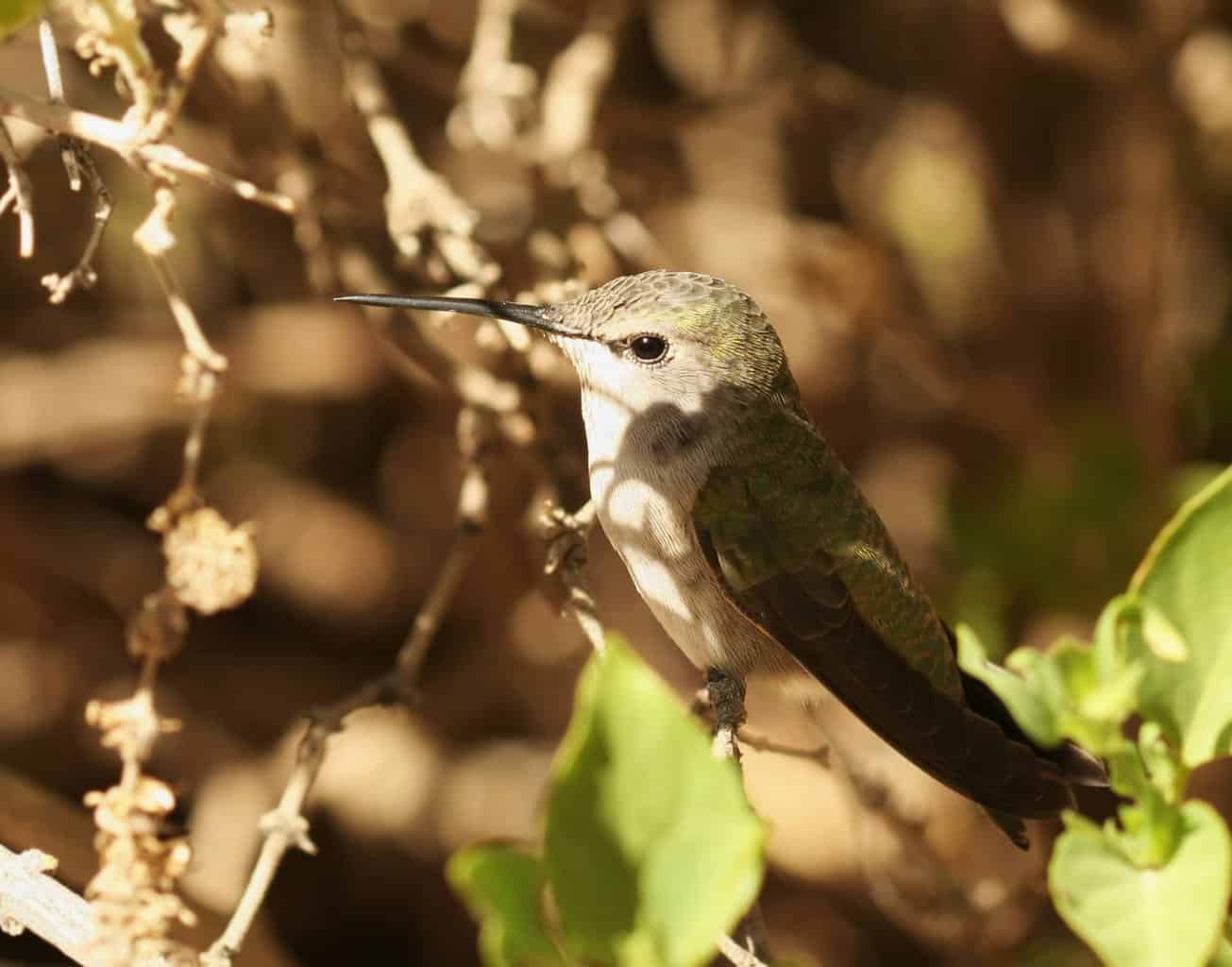
- Scientific Name: Selasphorus calliope
- Length: 8 – 3.9 inches
- Weight: 071 – 0.106 ounces
- Wingspan: 3 inches
- Native To: Mainly United States, Canada, And British Columbia
Description:
The Calliope hummingbirds have green and glossy feathers on their backs and crowns, with white bellies. The male Calliope hummingbird has wine-red streaks on his gorget with green flanks and a darker tail than the female.
The female has much the same coloring as the juveniles, with a pinkish color on their flanks, dark streaks on their throats, and dark tails tipped with white. This hummingbird is not sexually dimorphic like other hummingbirds.
Additional Information:
Calliope hummingbirds are the smallest native bird in the United States and Canada and will migrate to other states during the winter.
These hummingbirds will stay in lowland, bushy areas where they are hidden well. While these tiny birds are in the area, they will feed on nectar from flowers or eat small insects for protein.
Ruby-Throated Hummingbird
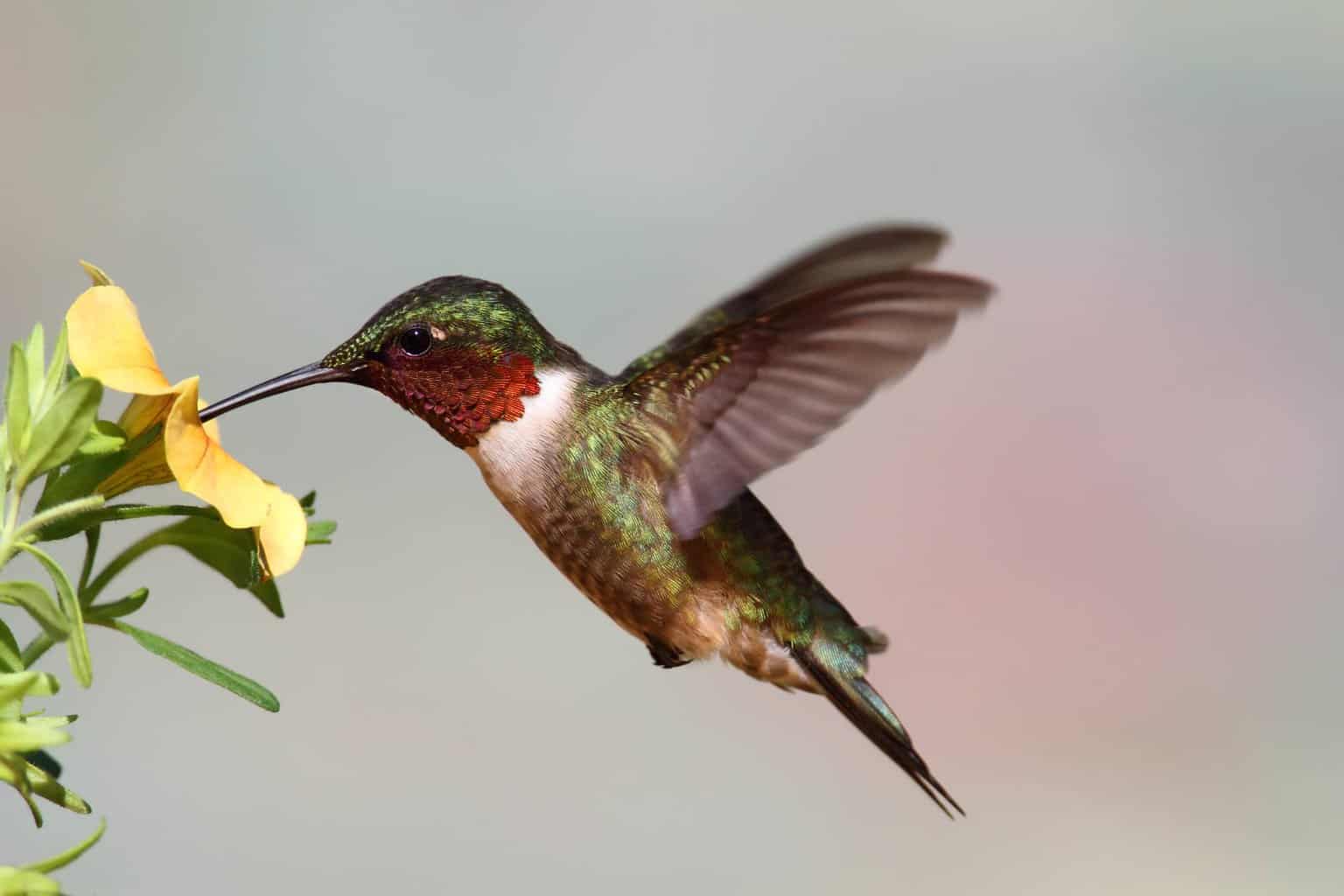
- Scientific Name: Archilochus colubris
- Length: 8 – 3.5 inches
- Weight: 071 – 0.212 ounces
- Wingspan: 1 – 4.3 inches
Native To: Large area Of Eastern North America
Description:
These hummingbirds have metallic green on their backs and grayish-white feathers on their bellies. They also have wings that are near-black when they are mature.
Red-throated hummingbirds have a long, very thin, and a straight bill that will grow about 0.79 inches in length.
The male has what is known as a gorget, which is a throat patch. This gorget is ruby red and is thinly bordered with a black line on the top.
The males have forked black tails with a glint of violet when in the sun. The females have notched tails, with the outer feathers banded in black, green, and white.
Additional Information:
The Ruby-throated hummingbird is a common hummingbird seen in Kansas; you will not see it all year round as it does migrate during the winter. In the winter, Ruby-throated hummingbirds will migrate to Mexico, Central America, Canada, Florida, and other states.
Red-throated hummingbirds are sexually dimorphic—the sexes will have different characteristics as they mature.
Rufous Hummingbird
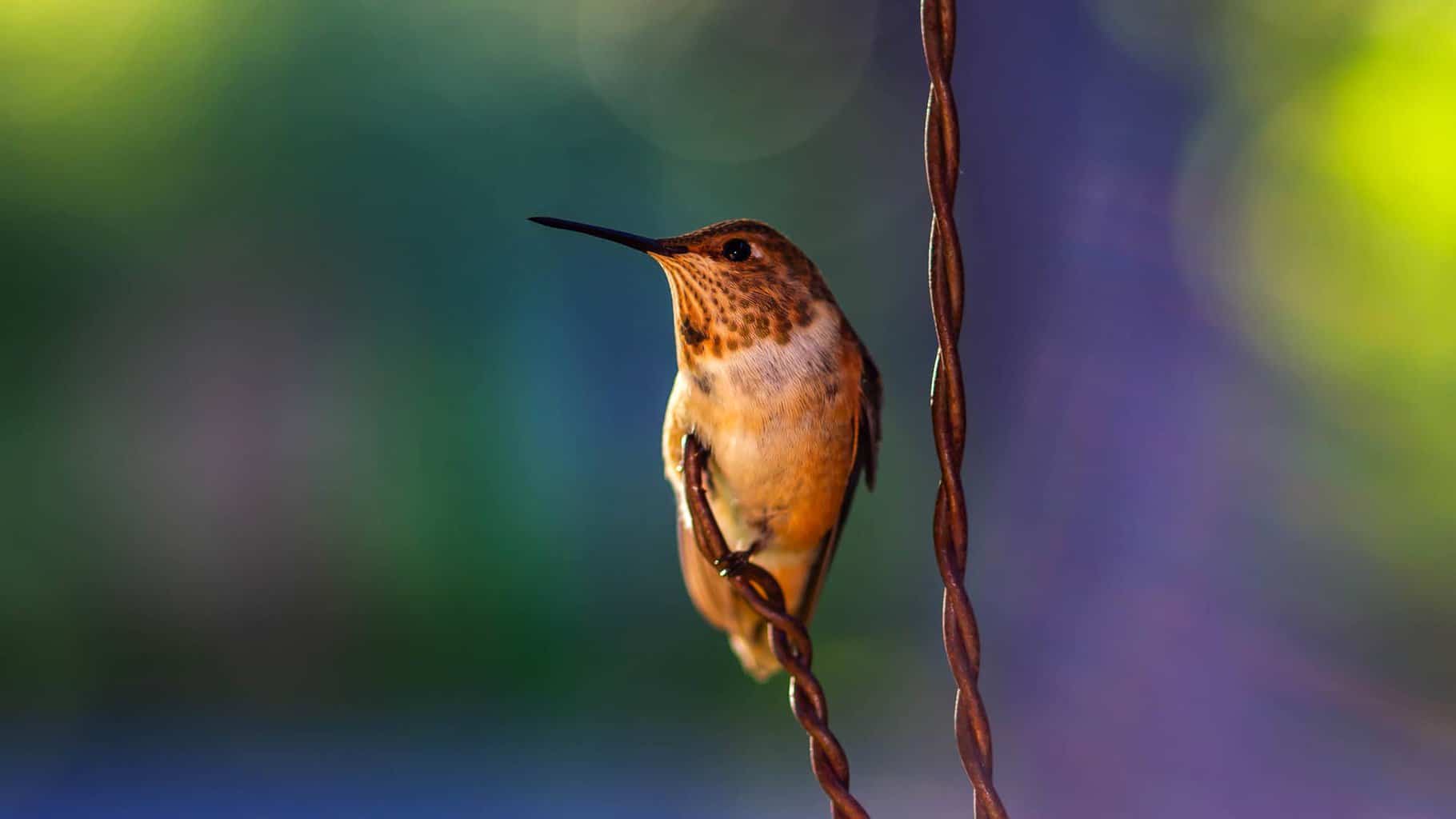
- Scientific Name: Selasphorus rufus
- Length: 1 inch
- Weight: 071 – 0.176 ounces
- Wingspan: 3 inches
- Native To: Large area of the United States
Description:
Both male and female Rufous hummingbirds have bright-colored feathers. The male’s chest is white, with a reddish-brown or rufous face. His flanks and tail are an iridescent reddish-orange along with his throat gorget.
Rufous hummingbirds will also have bits of green on their crowns and backs. The female is colored slightly differently, but not enough to be considered a sexually dimorphic bird.
The difference between the Rufous hummingbirds is that the females have white, green, and some iridescent orange feathers in the middle of their throats. They also have darker, rufous colored tails with white tips.
Additional Information:
The Rufous hummingbird is known for its exquisite flying skills, as this hummingbird files 2,000 miles in its yearly migratory trips. Notably, this hummingbird will migrate through the lower laying lands to take advantage of the lovely wildflower season.
The female Rufous hummingbird is also larger than the males.
Refulgent or Magnificent Hummingbird
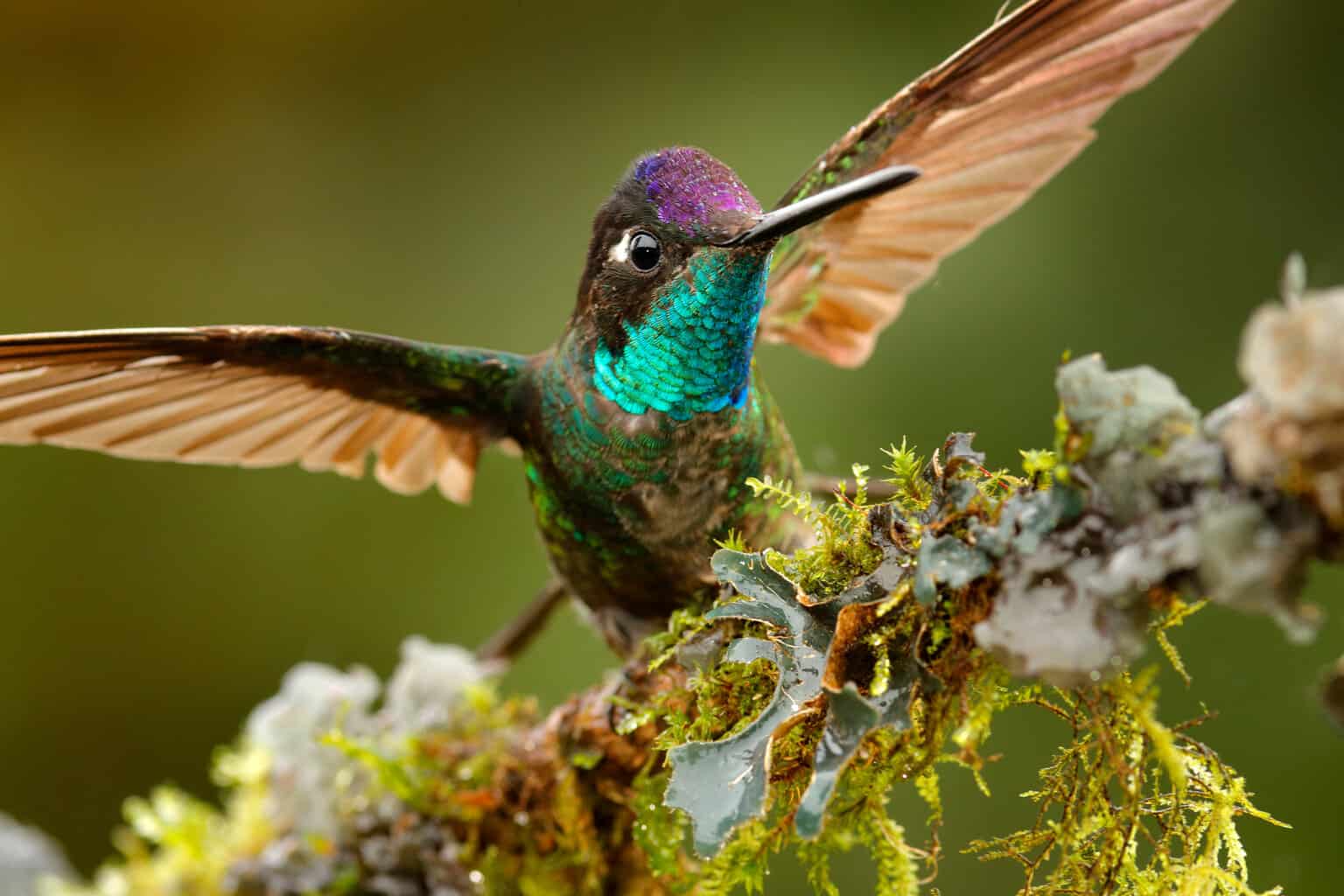
- Scientific Name: Eugenes fulgens
- Length: 3 – 5.5 inches
- Weight: 2 – 0.3 ounces
- Wingspan: 1 inch
- Native To: From Southwestern United States to Western Panama
Description:
These hummingbirds are not sexually dimorphic, with the male having a metallic green throat and a black chest.
The male’s crown and forehead are a purple color, and its back is dark green.
The female hummingbird’s feathers are less bright, and her chest is a solid gray. Her crown and back are a lovely olive green, while her tail feathers are tipped with a pearl gray.
These birds feed on nectar from brightly colored flowers, and they favor flowers with the highest sugar content.
Additional Information:
These hummingbirds are twice the size of other hummingbird species found in the United States, meaning they can often be identified by their size alone when they are among different hummingbirds.
Conclusion
Many hummingbirds can be found in Kansas, but the most common hummingbird in this state is the Ruby-throated hummingbird, with the other species on this list being a rarer sight.
These rarer hummingbird species will only be seen in Kansas during their migrating and breeding season.
These hummingbirds are beautiful and are worth the effort to try and see. During the migrating seasons, make sure you plant some nectar-producing plants.
If you are interested in any other birds in Kansas, take a look at this list of owls that bird admirers can find here.

